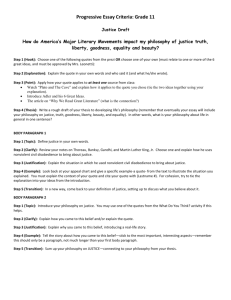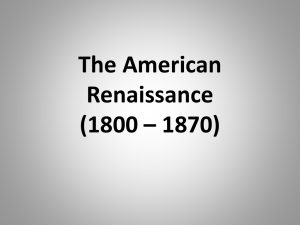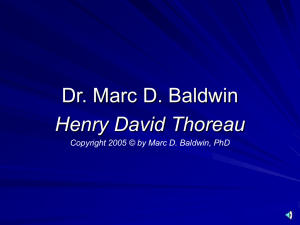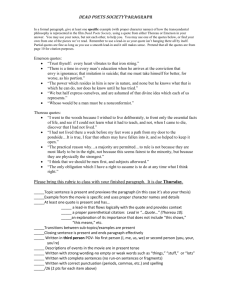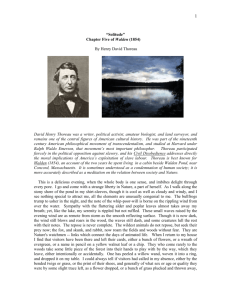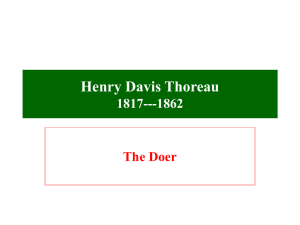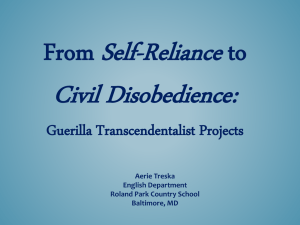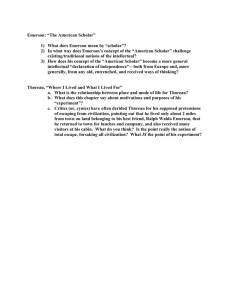Integrating Quotations: Punctuation & Techniques
advertisement
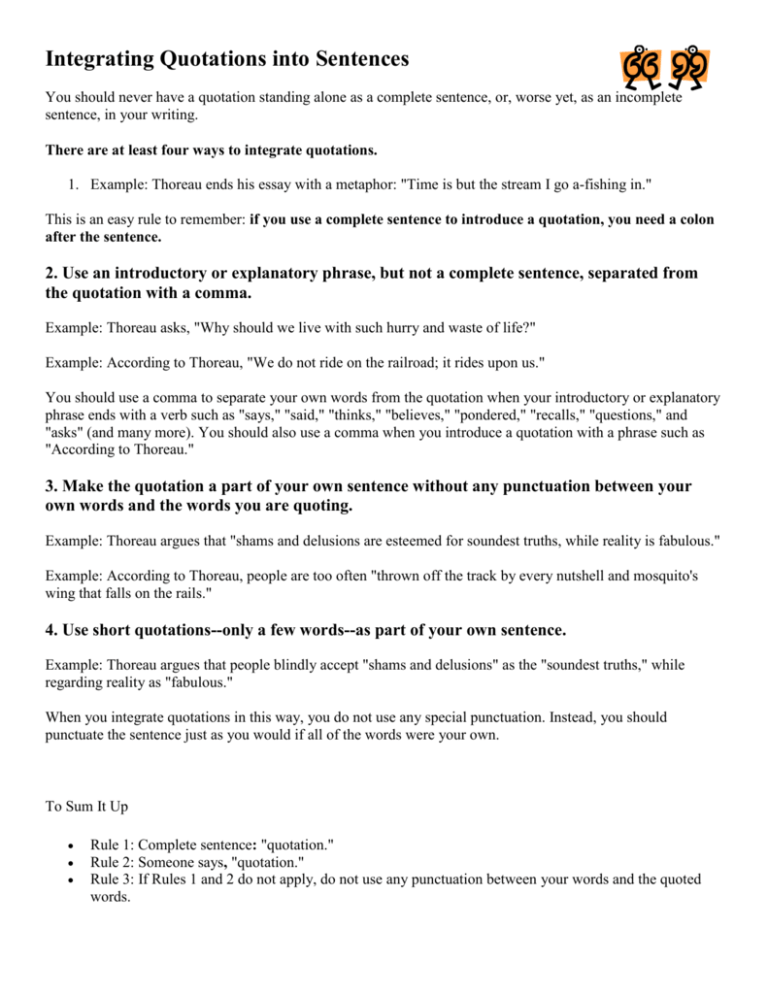
Integrating Quotations into Sentences You should never have a quotation standing alone as a complete sentence, or, worse yet, as an incomplete sentence, in your writing. There are at least four ways to integrate quotations. 1. Example: Thoreau ends his essay with a metaphor: "Time is but the stream I go a-fishing in." This is an easy rule to remember: if you use a complete sentence to introduce a quotation, you need a colon after the sentence. 2. Use an introductory or explanatory phrase, but not a complete sentence, separated from the quotation with a comma. Example: Thoreau asks, "Why should we live with such hurry and waste of life?" Example: According to Thoreau, "We do not ride on the railroad; it rides upon us." You should use a comma to separate your own words from the quotation when your introductory or explanatory phrase ends with a verb such as "says," "said," "thinks," "believes," "pondered," "recalls," "questions," and "asks" (and many more). You should also use a comma when you introduce a quotation with a phrase such as "According to Thoreau." 3. Make the quotation a part of your own sentence without any punctuation between your own words and the words you are quoting. Example: Thoreau argues that "shams and delusions are esteemed for soundest truths, while reality is fabulous." Example: According to Thoreau, people are too often "thrown off the track by every nutshell and mosquito's wing that falls on the rails." 4. Use short quotations--only a few words--as part of your own sentence. Example: Thoreau argues that people blindly accept "shams and delusions" as the "soundest truths," while regarding reality as "fabulous." When you integrate quotations in this way, you do not use any special punctuation. Instead, you should punctuate the sentence just as you would if all of the words were your own. To Sum It Up Rule 1: Complete sentence: "quotation." Rule 2: Someone says, "quotation." Rule 3: If Rules 1 and 2 do not apply, do not use any punctuation between your words and the quoted words. Quotation Integration – Remember the formula: SET THE STAGE INCLUDE A QUOTE EXPLAIN IT Below is an example from a character study of Harry Potter in which the writer shows how Harry goes from loser to legend in Harry Potter and the Sorcerer’s Stone: SET THE STAGE J.K. Rowling’s initial description of Harry Potter is anything but heroic. In Harry Potter and the Sorcerer’s Stone, Rowling describes Harry in great detail: INCLUDE Harry had a think face, knobbly knees, black hair, and bright green eyes. He wore round glasses held together with a lot of Scotch tape because of all the times Dudley had punched him on the nose. The only thing Harry liked about his own appearance was a very thin scar on his forehead that was shaped like a lightning bolt (Rowling 20). A QUOTE Harry may be the very picture of a loser and a weakling. Yet even here, Rowling reminds the reader of Harry’s destiny with references to his “bright green eyes” and to his lightning-bolt scar, a sign of his power against he formidable Voldemort. EXPLAIN IT **The above example is formatted as option 3, however, the technique of set the stage, include a quote, and explain it can be followed for any of the three options. Quick Tips You want to STAY AWAY from statements like o “On page 24, the narrator says…” o “In chapter 3, this quote says…” DO NOT announce the quoted material o This quote shows that… o This means that… o The author means that… o The character means that… o The author says that… o The character says that… DO NOT have the quote be in a sentence all by itself o Wrong: They were all shocked. “The windmill was in ruins” (71). o Right: At this moment, Whitney knew that “she was destined for greatness” (54). DO NOT just repeat what the quote already says in your explanation Remember this formula for using quotes in your essays: o Set the stage o Include a quote o Explain it Do NOT start or end a paragraph with a quotation; make sure there is a reason you are using another’s idea at that particular place in the essay. It should belong there and support your point. Never use a direct quotation as a way to avoid thinking. All quotes must be selected purposefully, introduced intelligently, and explained thoroughly. Examples Example #1: At first, Juliet had doubts about their future. She tells Romeo that the marriage is “too rash, too unadvised, too sudden” (645). Juliet’s hesitation illustrates her impressive foresight; she is able to see the possible consequences to their hasty actions. Example #2: Terence, in an effort to counter his friend’s complaint about the mournful nature of his poetry, reminds him, “There’s brisker pipes than poetry”(16). His ironic suggestion to turn to liquor suggests his attitude that people look to both poetry and alcohol for the wrong reasons. Quotation Integration Practice Now that we have discussed the proper format for integrating quotations in an analytical essay, try integrating these quotes! Essay topic: Charlotte is courageous. Quote: Page 124 “I would never come down alive! And yet I had to climb. This was my restitution.” Integrate the quote (set the stage, quote, explanation) _____________________________________________________________________________ ____________________________________________________________________________ _____________________________________________________________________________ _____________________________________________________________________________ Essay topic: Charlotte is courageous. Quote: Page 113 “I’ve come to be one of the crew.” Integrate the quote (set the stage, quote, explanation) _____________________________________________________________________________ _____________________________________________________________________________ _____________________________________________________________________________ _____________________________________________________________________________ Proper In-text Citation A General Rule: Any time you copy words directly from printed material, you must place quotation marks around those words. Since the words are not your own, you must give the author credit. How to do it: Once you have smoothly integrated your quote (set the stage, quote, and explain) you must cite the work from which you found the quotation. Step 1: Make sure you have quotation marks around the quote Step 2: Leave off the punctuation at the end of the sentence Step 3: After the end quotation marks, put the author’s name and page number in parentheses. Step 4: Close the parentheses and put a period. Example: Miss O’Shay tells Nancy Lee of her Irish decent and that “years ago, we were called the dirty Irish, and mobs rioted against us in the big cities, and we were invited to go back where we came from. But we didn’t go. And we didn’t give up, because we believed in the American dream, and in our power to make that dream come true” (Hughes 50). ----------------------------------------------------------------------------------Try it out: Rewrite the following quotes with the proper in-text citation. Author: Langston Hughes Page: 49 Quote: We still have in this world of ours, democracy to make…Lift up your head, Nancy Lee, and smile at me. ___________________________________________________________________________________ _______________________________________________________ Author: Avi Page: 42 Quote: I had never met with such impertinence that this Zachariah…my inferior, should tell me such slanderous tales. ___________________________________________________________________________________ _______________________________________________________ Practice Quiz: Quotations and Punctuation From each set of sentences below, choose the sentence with the correct punctuation, if any punctuation is needed, between the writer's words and the quoted words. 1. Thoreau asks "If the bell rings, why should we run?" A. Thoreau asks "If the bell rings, why should we run?" (no punctuation) B. Thoreau asks, "If the bell rings, why should we run?" C. Thoreau asks; "If the bell rings, why should we run?" D. Thoreau asks: "If the bell rings, why should we run?" 2. Thoreau says that "We are determined to be starved before we are hungry." A. Thoreau says that "We are determined to be starved before we are hungry." (no punctuation) B. Thoreau says that. "We are determined to be starved before we are hungry." C. Thoreau says that; "We are determined to be starved before we are hungry." D. Thoreau says that: "We are determined to be starved before we are hungry." 3. Thoreau explains why he decided to live in the woods "I did not wish to live what was not life, living is so dear; nor did I wish to practise resignation, unless it was quite necessary." A. Thoreau explains why he decided to live in the woods "I did not wish to live what was not life, living is so dear; nor did I wish to practise resignation, unless it was quite necessary." (no punctuation) B. Thoreau explains why he decided to live in the woods, "I did not wish to live what was not life, living is so dear; nor did I wish to practise resignation, unless it was quite necessary." C. Thoreau explains why he decided to live in the woods; "I did not wish to live what was not life, living is so dear; nor did I wish to practise resignation, unless it was quite necessary." D. Thoreau explains why he decided to live in the woods: "I did not wish to live what was not life, living is so dear; nor did I wish to practise resignation, unless it was quite necessary." 4. Thoreau explains why he decided to live in the woods when he says that "I did not wish to live what was not life, living is so dear; nor did I wish to practise resignation, unless it was quite necessary." A. Thoreau explains why he decided to live in the woods when he says that "I did not wish to live what was not life, living is so dear; nor did I wish to practise resignation, unless it was quite necessary." (no punctuation) B. Thoreau explains why he decided to live in the woods when he says that, "I did not wish to live what was not life, living is so dear; nor did I wish to practise resignation, unless it was quite necessary." C. Thoreau explains why he decided to live in the woods when he says that; "I did not wish to live what was not life, living is so dear; nor did I wish to practise resignation, unless it was quite necessary." D. Thoreau explains why he decided to live in the woods when he says that: "I did not wish to live what was not life, living is so dear; nor did I wish to practise resignation, unless it was quite necessary." 5. Thoreau explains why he decided to live in the woods when he says "I did not wish to live what was not life, living is so dear; nor did I wish to practise resignation, unless it was quite necessary." A. Thoreau explains why he decided to live in the woods when he says "I did not wish to live what was not life, living is so dear; nor did I wish to practise resignation, unless it was quite necessary." (no punctuation) B. Thoreau explains why he decided to live in the woods when he says, "I did not wish to live what was not life, living is so dear; nor did I wish to practise resignation, unless it was quite necessary." C. Thoreau explains why he decided to live in the woods when he says; "I did not wish to live what was not life, living is so dear; nor did I wish to practise resignation, unless it was quite necessary." D. Thoreau explains why he decided to live in the woods when he says: "I did not wish to live what was not life, living is so dear; nor did I wish to practise resignation, unless it was quite necessary." 6. Thoreau summarizes how he thinks we can improve our lives "Simplify, simplify." A. Thoreau summarizes how he thinks we can improve our lives "Simplify, simplify." (no punctuation) B. Thoreau summarizes how he thinks we can improve our lives, "Simplify, simplify." C. Thoreau summarizes how he thinks we can improve our lives; "Simplify, simplify." D. Thoreau summarizes how he thinks we can improve our lives: "Simplify, simplify."

